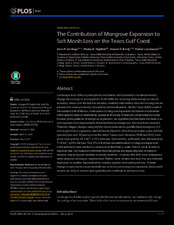| dc.creator | Armitage, Anna R. | |
| dc.creator | Highfield, Wesley E. | |
| dc.creator | Brody, Samuel D. | |
| dc.creator | Louchouarn, Patrick | |
| dc.date.accessioned | 2015-08-12T21:02:50Z | |
| dc.date.available | 2015-08-12T21:02:50Z | |
| dc.date.issued | 2015-05-06 | |
| dc.identifier.citation | Armitage AR, Highfield WE, Brody SD, Louchouarn P (2015) The Contribution of Mangrove Expansion to Salt Marsh Loss on the Texas Gulf Coast. PLoS ONE 10(5): e0125404. doi:10.1371/journal.pone.0125404 | en |
| dc.identifier.uri | https://hdl.handle.net/1969.1/154774 | |
| dc.description.abstract | Landscape-level shifts in plant species distribution and abundance can fundamentally change the ecology of an ecosystem. Such shifts are occurring within mangrove-marsh ecotones, where over the last few decades, relatively mild winters have led to mangrove expansion into areas previously occupied by salt marsh plants. On the Texas (USA) coast of the western Gulf of Mexico, most cases of mangrove expansion have been documented within specific bays or watersheds. Based on this body of relatively small-scale work and broader global patterns of mangrove expansion, we hypothesized that there has been a recent regional-level displacement of salt marshes by mangroves. We classified Landsat-5 Thematic Mapper images using artificial neural networks to quantify black mangrove (Avicennia germinans) expansion and salt marsh (Spartina alterniflora and other grass and forb species) loss over 20 years across the entire Texas coast. Between 1990 and 2010, mangrove area grew by 16.1 km2, a 74% increase. Concurrently, salt marsh area decreased by 77.8 km2, a 24% net loss. Only 6% of that loss was attributable to mangrove expansion; most salt marsh was lost due to conversion to tidal flats or water, likely a result of relative sea level rise. Our research confirmed that mangroves are expanding and, in some instances, displacing salt marshes at certain locations. However, this shift is not widespread when analyzed at a larger, regional level. Rather, local, relative sea level rise was indirectly implicated as another important driver causing regional-level salt marsh loss. Climate change is expected to accelerate both sea level rise and mangrove expansion; these mechanisms are likely to interact synergistically and contribute to salt marsh loss. | en |
| dc.description.sponsorship | The open access fee for this work was funded through the Texas A&M University Open Access to Knowledge (OAK) Fund. | en |
| dc.language.iso | en_US | |
| dc.publisher | PLOS | |
| dc.rights | Attribution 3.0 United States | en |
| dc.rights.uri | http://creativecommons.org/licenses/by/3.0/us/ | |
| dc.subject | Mangrove swamps | en |
| dc.subject | Marshes | en |
| dc.subject | Habitats | en |
| dc.subject | Wetlands | en |
| dc.subject | Texas | en |
| dc.subject | Gulf of Mexico | en |
| dc.subject | Artificial neural networks | en |
| dc.subject | Winter | en |
| dc.title | The contribution of mangrove expansion to salt marsh loss on the Texas Gulf coast | en |
| dc.type | Article | en |
| local.department | Other | en |



